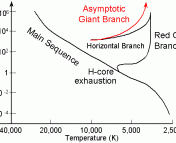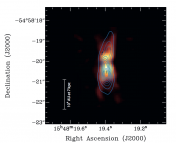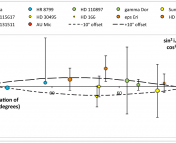Title: (Sub)stellar companions shape the winds of evolved stars
Authors: L. Decin, M. Montargès, A. M. S. Richards, C. A. Gottlieb, W. Homan, I. McDonald, I. El Mellah, T. Danilovich, S. H. J. Wallström, A. Zijlstra, A. Baudry, J. Bolte, E. Cannon, E. De Beck, F. De Ceuster, A. de Koter, J. De Ridder, S. Etoka, D. Gobrecht, M. Gray, F. Herpin, M. Jeste, E. Lagadec, P. Kervella, T. Khouri, K. Menten, T. J. Millar, H. S. P. Müller, J. M. C. Plane, R. Sahai, H. Sana, M. Van de Sande, L. B. F. M. Waters, K. T. Wong, J. Yates
First Author’s Institution: Institute of Astronomy, KU Leuven
Status: Published in Science [closed access]
Astronomers tend to have a flair for the dramatic: they make beautiful images of outer space objects and constantly, with unwavering enthusiasm, show them around to amaze people everywhere. And rightly so! Mesmerizing pictures are made of the Moon, the Sun, the planets, the Milky Way and colorful nebulae. One group of nebulae, the planetary nebulae, actually originate from stars much like our Sun and come in a wide variety of shapes, with a few examples shown in Figure 1. These planetary nebulae form when stars like the Sun reach the end of their lives. Instead of violently tearing apart in a supernova explosion like the Sun’s more massive cousins, a star like the Sun will gently push away its outer layers at the end of its life and will eventually leave behind a white dwarf. The light of this white dwarf illuminates the formerly expelled gas, and a range of chemical reactions in this gas leads to the rainbow of colors we observe in planetary nebulae.

Beautiful as they are, there is something off about these nebulae. Why are their shapes so complex and diverse? Why aren’t they just round, like the stars they originate from? The Sun, even though its radius is slightly larger at the equator than at the poles, is pretty round. Then how could a star like our Sun create the complex shapes of, say, the Cat’s Eye Nebula in Fig. 1? The short answer to this question is: binaries!
Binaries?
Yes, binaries. But before we come to that, we need some extra information. The authors of this study investigated Asymptotic Giant Branch (AGB) stars, stars like our Sun at the end of their lives that are the forerunners of planetary nebulae. These stars are in the process of expelling gas through stellar winds that will eventually form the illuminated shell of a planetary nebula, in the process losing a large fraction of their initial mass.

By looking at radio waves emitted by certain molecules (CO and SiO) in these stellar winds using the powerful radio antennae of the ALMA observatory in the Atacama desert, the authors were able to resolve the stellar winds of AGB stars. The shapes of these winds are shown in Figure 2, where reddish colors indicate material moving away from us and blueish colors indicate material moving towards us. This shows that even in the AGB star phase – way before the planetary nebula forms – the stellar winds already exhibit complex shapes similar to those seen in planetary nebulae.
All the AGB star samples in Fig. 2 are suspected to be in a binary system. Coincidence? The authors thought not! They found that only a binary system can cause these complex shapes in the stellar wind. They also found a connection between the general shapes of these winds and the stage where the AGB star is found. In Fig. 2 you can see disk-like structures (panels A & B), bipolar structures (D & E) and spiral structures (K & L). When AGB stars live in a binary system and lose mass, their distance to the companion star will grow due to the conservation of angular momentum. This process and the connection with the wind structures is also illustrated in Figure 3, showing the evolution of the binary system over time from left to right.
Today’s paper confirms the long-standing idea that something extra is needed aside from a lone AGB star to eventually form the weird shapes of planetary nebulae. This raises an interesting question: what will happen to the Sun at the end of its life? Like most other stars of similar mass, the Sun will turn into an AGB star over the next several billion years and will turn eventually into a white dwarf surrounded by a planetary nebula.

We are pretty sure that the Sun is not in a binary system (although it may have been in the past). But our Solar system does have some rather large planets: Jupiter and Saturn might have a similar effect as a far distant and very light-weight binary companion star of the Sun, forming a very light spiral in the Sun’s future stellar wind. Although the Sun will die eventually, it may very well leave a beautiful planetary nebula behind like the ones we observe today.
Astrobite edited by Sarah Bodansky, Mia de los Reyes and Lina Kimmig
Featured image credit: R. Sahai (Jet Propulsion Lab), B. Balick (University of Washington)





Amazing! Thank you for the understandable review 😀